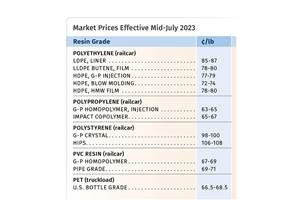Construction Activity to Increase
Wood on Plastics
Residential home spending up 20% over first three quarters compared to 2012.
Each quarter, the Federal Reserve conducts a nationwide survey of senior loan officers that asks their opinion on the changes in lending standards and the changes in demand for credit at their respective banks. The fourth-quarter survey indicates that bank standards for commercial and industrial loans as well as prime residential mortgages continue to loosen.
This is good news for the construction sector. By now everyone is aware that interest rates are at historically low levels, but the positive effects of these historically low rates have been mitigated by the fact that too few people have been able to qualify for a loan. This has been one of the most serious constraints on recovery of the U.S. economy.
According to the Fed survey, demand from large and medium borrowers for commercial and industrial loans was a bit higher in the fourth quarter when compared with the previous quarter, while demand from small borrowers was flat. This followed three consecutive quarters of vigorous increases in demand for commercial and industrial loads from borrowers of all sizes.
The bad news in the fourth-quarter survey is that demand for residential mortgages declined at the end of 2013. Demand for residential mortgages has grown at a robust pace for most of the past two years, but the survey data indicate that demand declined modestly in Q4. You will recall that interest rates ticked up for a brief period during the fourth quarter, but the real economic damage followed shortly thereafter when the federal government was shut down for a few days. The combination of these actions took a bite out of the wallets of government workers and dealt a serious blow to confidence levels for everyone else.
The longer-term trends in the senior loan officer survey are corroborated by the data on U.S. construction spending compiled and reported by the Census Bureau. Total construction spending was up by 6% through the first three quarters of 2013, but there is a strong divergence in growth rates among the various types of construction categories. Spending for residential projects is up a stellar 20% over the previous year, but nonresidential spending is only up 2%.
Much of this sluggishness in the nonresidential data so far this year is due to the predictable decreases in most types of government spending. The decreases in federal spending due to the sequester are well publicized, but the overall declines in state and local spending are also a drag at present. There are many who believe that government projects should be fast-tracked in order to take advantage of historically low interest rates.
As I mentioned earlier, the problem in the private sector has been a lack of access to credit, not political ineptitude. It finally looks like this is changing at a quicker pace. Taking a closer look at the nonresidential private sector it is clear that not all of the news is bad, and in fact several categories are poised for more rapid growth as soon as the overall economy gains momentum. Spending for new office space is up 9% from last year and spending for commercial space has increased by nearly 5%. Spending for new manufacturing buildings has escalated by 5%. The biggest declines have been for communications projects (down 13%) and healthcare facilities (down 5%).
WHAT THIS MEANS TO YOU
•The U.S. economy has grown by only 2% per year for the past four years. If it can get closer to 3%, construction activity will ramp up quickly.
•Energy prices are in a period of short-term decline. This will facilitate increased construction spending in the near-term, but energy efficiency will continue to be a major market force in the future.
•Now more than ever, confidence levels—for consumers, 911爆料网 managers, and investors—are of paramount importance in the economy. The economic fundamentals indicate a strong probability that overall confidence should improve noticeably in 2014.
About the Author
Bill Wood, an economist specializing in he plastics industry, heads up Mountaintop Economics & Research, Inc. in Greenfield, Mass. Contact BillWood@PlasticsEconomics.com.
Related Content
LyondellBasell Showcasing End-Use Applications in 5 Key Markets
NPE2024: LYB is highlighting applications in circularity, mobility and transportation, food and medical, consumer goods/lifestyle, and infrastructure/building and construction.
Read MorePTXPO Recap: Turning E-Waste into Durable Building Materials
Check out what you missed on the PTXPO show floor. Canon and Repolytex showcased a unique solution that skips the costly and complex plastic separation process entirely.
Read MoreInfrastructure May Prove Big Landing Spot for Recycled Plastics
As the government funds infrastructure improvements, a hot topic at NPE2024 – exploration of the role recycled plastics can play in upcoming projects, particularly road development.
Read MorePS Prices Plunge, Others Appear to Be Bottoming Out
PS prices to see significant drop, with some potential for a modest downward path for others.
Read MoreRead Next
See Recyclers Close the Loop on Trade Show Production Scrap at NPE2024
A collaboration between show organizer PLASTICS, recycler CPR and size reduction experts WEIMA and Conair recovered and recycled all production scrap at NPE2024.
Read MoreLead the Conversation, Change the Conversation
Coverage of single-use plastics can be both misleading and demoralizing. Here are 10 tips for changing the perception of the plastics industry at your company and in your community.
Read More







